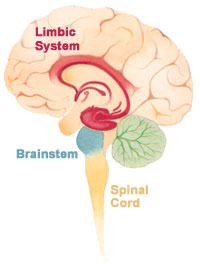orgasm
An orgasm (from Greek orgasmos, from organ to mature, swell, also sexual climax) is the peak of the plateau phase of the sexual response cycle, characterized by an intense sensation of pleasure.[1] Experienced by both males and females, orgasm is controlled by the involuntary, or autonomic, limbic system, and is accompanied by quick cycles of muscle contraction in the lower pelvic muscles, which surround the primary sexual organs and the anus. Orgasms are often associated with other involuntary actions, including muscular spasms in multiple areas of the body, a general euphoric sensation and, frequently, body movements and vocalizations are expressed.
Orgasm is an autonomic physiologic response to sexual stimulation. Brain activity scans indicate the importance of the limbic system in the orgasmic response.[citation needed] In humans, orgasms usually result from the stimulation of the penis in males and the clitoris in females. Stimulation can be by self (masturbation) or by a partner (sexual intercourse, oral sex, mutual masturbation, etc.). Partners simultaneously stimulating each other's sex organs by mutual masturbation, penetrative intercourse, or other rhythmic inter-genital contact may experience simultaneous orgasms. Partners can learn to control their own and each other's orgasms.
The period after orgasm (known as a Refractory period) is often a relaxing experience, attributed to the release of the neurohormones oxytocin and prolactin.[2] Male and female brains demonstrate similar changes during orgasm (by partner controlled orgasm), with brain activity scans showing a temporary decrease in the metabolic activity of large parts of the cerebral cortex with normal or increased metabolic activity in the limbic areas of the brain.[3]
http://en.wikipedia.org/wiki/Orgasm





0 Comments:
Post a Comment
Subscribe to Post Comments [Atom]
<< Home